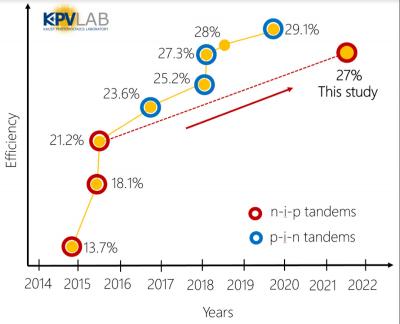Researchers from King Abdullah University of Science and Technology (KAUST) in Saudi Arabia, in collaboration with University of Toronto, the National University of Singapore and National Technical University of Athens, have designed monolithic tandem solar cell with power conversion efficiency of 27%, surpassing the previous best reported value of 22% in the same configuration.

The team explains that translating the high power conversion efficiencies of single-junction perovskite solar cells in their classic, non-inverted (n'i'p) architecture to efficient monolithic n'i'p perovskite/silicon tandem solar cells with high current densities has been a persistent challenge due to the lack of low-temperature processable, chemically-insoluble contact materials with appropriate polarity and sufficient optical transparency. To address this, they developed sputtered amorphous niobium oxide (a-NbOx) with ligand-bridged C60 as an efficient electron-selective contact, deposited on the textured-silicon bottom cell.
Combining these contact materials with two-dimensional perovskite passivation on the micrometer-thick solution-processed perovskite top cell yielded 27% efficient monolithic n'i'p perovskite/silicon tandem solar cells, which represents one of the highest power conversion efficiencies reported on pyramidal textured crystalline silicon bottom cells, and the highest with this polarity.
Erkan Aydin, the leading author of the project, said: 'We overcome the persistent challenges of the n-i-p perovskite/silicon tandem solar cell platform and unveil the true potential of this architecture'.
'Overall, we allowed more light to be captured in the regular structured tandem solar cells, and we converted the absorbed to energy more effectively thanks to our newly developed contacting materials", says Erkan Aydin and adds 'With these advancements, we achieved a power conversion efficiency exceeding 27%. This represents a significant advance over the best prior report in the n-i-p configuration of only ~22% on similar bottom cells.'
Members of the collaborative team said that 'Our agenda-setting results enable a new tandem device platform' and added: 'This new device platform allows for translating the achievements of n-i-p single-junction solar cells into the context of tandems'.
The team expects rapid progress to be achieved in the field of perovskite/silicon tandems in the n-i-p configuration thanks to these advancements.
Also, they add 'Beyond this, we expect our research will also propel the perovskite/perovskite tandem solar cells research suffering from a lack of efficient vacuum-deposited hole selective contacts, where we offer a unique solution here. In addition, this platform enables the utilization of tandems as a photocathode in efficient solar-driven water splitting applications for hydrogen generation more effectively than the p-i-n configuration devices.'
The team plans to continue improving the efficiencies of those devices, which can be more efficient than today's inverted (p-i-n) structure devices.

